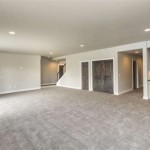Paint Colors For Basement Stairwell Walls: Illuminating and Enhancing Your Space
The basement stairwell is often an overlooked area in home design, frequently relegated to a purely functional space. However, it presents a valuable opportunity to enhance the overall aesthetic of the home, improve safety, and create a more inviting transition between levels. Selecting the appropriate paint colors for basement stairwell walls is crucial in achieving these goals. Considerations should extend beyond mere aesthetics to encompass factors such as lighting, spatial perception, and the existing decor of both the main floor and the basement.
Choosing paint colors for a basement stairwell requires a thoughtful approach, taking into account the unique challenges and opportunities presented by this transitional space. Unlike other rooms in the home, stairwells often suffer from limited natural light and can feel cramped or dark. The right paint color can significantly mitigate these issues, creating a brighter, more spacious, and visually appealing environment. This article will explore key considerations for selecting paint colors for basement stairwell walls, including the impact of light, strategies for creating visual interest, and tips for coordinating colors with the surrounding spaces.
Understanding the Impact of Light on Paint Color
One of the most crucial factors to consider when selecting paint colors for a basement stairwell is the amount of natural and artificial light available. Basements, by their nature, tend to receive less natural light than upper floors, and stairwells are often further deprived of illumination due to their enclosed nature. Dark colors absorb light, making the space feel even smaller and darker. Conversely, light and bright colors reflect light, creating a more open and airy ambiance.
For basement stairwells with minimal natural light, opting for lighter paint colors is generally recommended. Whites, off-whites, and very pale shades of gray, beige, or even soft pastels can significantly brighten the space. These colors reflect the available light, making the stairwell feel more spacious and inviting. It is important to note that even within the "white" category, there are numerous variations, each with subtle undertones that can affect the overall perception of the space. Cool whites, with blue or green undertones, can create a clean and modern feel, while warm whites, with yellow or orange undertones, can add a touch of warmth and coziness.
The type of artificial lighting used in the stairwell also plays a role in how paint colors appear. Incandescent lighting tends to cast a warm, yellowish glow, which can enhance warm-toned paint colors but may make cool-toned colors appear dull. LED lighting, on the other hand, typically emits a cooler, more neutral light, which renders colors more accurately. It is advisable to test paint samples under the stairwell's artificial lighting conditions before making a final decision to ensure the chosen color appears as intended.
Gloss level also influences how light is reflected. Higher gloss paints, such as semi-gloss or gloss, reflect more light than matte or eggshell finishes. While higher gloss paints can brighten the space, they also tend to highlight imperfections on the walls. For stairwells with uneven surfaces, a matte or eggshell finish may be preferable, as they are more forgiving and can help to conceal minor flaws. However, these finishes are less durable and more difficult to clean, which is an important consideration for a high-traffic area like a stairwell.
Creating Visual Interest and Depth
While lightness is often a primary concern, it is also important to incorporate visual interest and depth into the basement stairwell. A monochromatic scheme of entirely light colors can feel bland and uninspired. Introducing contrasting colors, textures, or patterns can add personality and make the stairwell a more visually appealing space. This can be achieved through various techniques, such as accent walls, painted trim, or the use of stencils or wallpaper.
An accent wall, painted in a darker or bolder color, can serve as a focal point in the stairwell. For example, the wall at the bottom of the stairs or the landing can be painted in a contrasting color to draw the eye and add depth. When selecting an accent color, consider the existing decor of the main floor and the basement. Choose a color that complements the overall color scheme and creates a cohesive transition between the two levels. Depending on the desired aesthetic, the accent color can be a bold and vibrant hue or a more muted and sophisticated shade.
Painting the trim, including the baseboards, door frames, and handrails, in a contrasting color can also add visual interest. White trim is a classic and versatile choice that works well with a variety of wall colors. However, consider painting the trim in a darker color, such as gray or black, to create a more dramatic effect. This is particularly effective when paired with lighter wall colors, as it creates a strong contrast that highlights the architectural details of the stairwell.
Stencils and wallpaper offer another way to add visual interest and texture to the basement stairwell walls. Stencils can be used to create intricate patterns or decorative motifs that complement the overall design scheme. Wallpaper, with its variety of textures, patterns, and colors, can transform the stairwell into a statement space. When selecting wallpaper, consider the scale of the pattern in relation to the size of the stairwell. Smaller patterns tend to work better in confined spaces, while larger patterns can overwhelm the area. The texture of the wallpaper can also add depth and dimension to the walls. Textured wallpapers, such as grasscloth or embossed designs, can create a more tactile and visually engaging environment.
Coordinating Colors with Surrounding Spaces
The basement stairwell serves as a transitional space between the main floor and the basement, making it crucial to coordinate the paint colors with the surrounding areas. The color scheme should create a cohesive and harmonious flow between the two levels, rather than feeling disjointed or jarring. This does not necessarily mean that the colors must be identical, but they should complement each other and create a sense of visual continuity.
Consider the color scheme of the main floor when selecting paint colors for the basement stairwell. If the main floor features a warm and inviting color palette of beige, cream, and earth tones, consider using similar colors in the stairwell to create a seamless transition. Alternatively, if the main floor boasts a more modern and minimalist aesthetic with cool grays and whites, continue this theme into the stairwell for a consistent look. The goal is to create a sense of unity and coherence between the two levels.
The color scheme of the basement should also be taken into account. If the basement is designed as a cozy and comfortable living space, consider using warmer colors in the stairwell to complement the overall ambiance. Alternatively, if the basement serves as a functional space, such as a laundry room or storage area, lighter and brighter colors may be more appropriate to create a clean and organized feel. Consider the overall purpose and design aesthetic of the basement when selecting paint colors for the stairwell.
The flooring material in the stairwell also influences the choice of paint colors. Matching the wall color with the stair treads creates a cohesive design flow but might not always be practical, especially when considering cleaning and wear. Instead, consider using complementary colors or tones. If the stair treads are dark wood, lighter wall colors can create a striking contrast and visually lift the space. Conversely, if the treads are light-colored, darker wall colors can create a grounded and sophisticated look. Pay attention to the undertones of the flooring material when selecting paint colors to ensure a harmonious combination.
In conclusion, the selection of paint colors for basement stairwell walls should consider the impact of light, strategies for creating visual interest, and the importance of coordinating colors with surrounding spaces. By carefully considering these factors, homeowners can transform their basement stairwell into a brighter, more inviting, and visually appealing space that seamlessly connects the main floor and the basement.

The 5 Best Paint Colors For A Dark Hallway Stairs Design House Stairwell Wall

Best Paint For Stairs In A Basement

32 Best Basement Paint Colors

Basement Makeover Painting Stairs Black Building Bluebird

Our Basement Staircase Transformation Reveal From Concrete To Colorful

Accent Wall And Original Staircase Colors Stairwell Color

7 Stunning Painted Stairs Inspiring Color Ideas For Staircase Beamin Moore

9 Best Basement Paint Colors How To Pick Color Concierge

April 2024 Basement Steps Ranch House Remodel Makeover

What Color Should I Paint My Basement How To Choose The Best Colors For Basements







